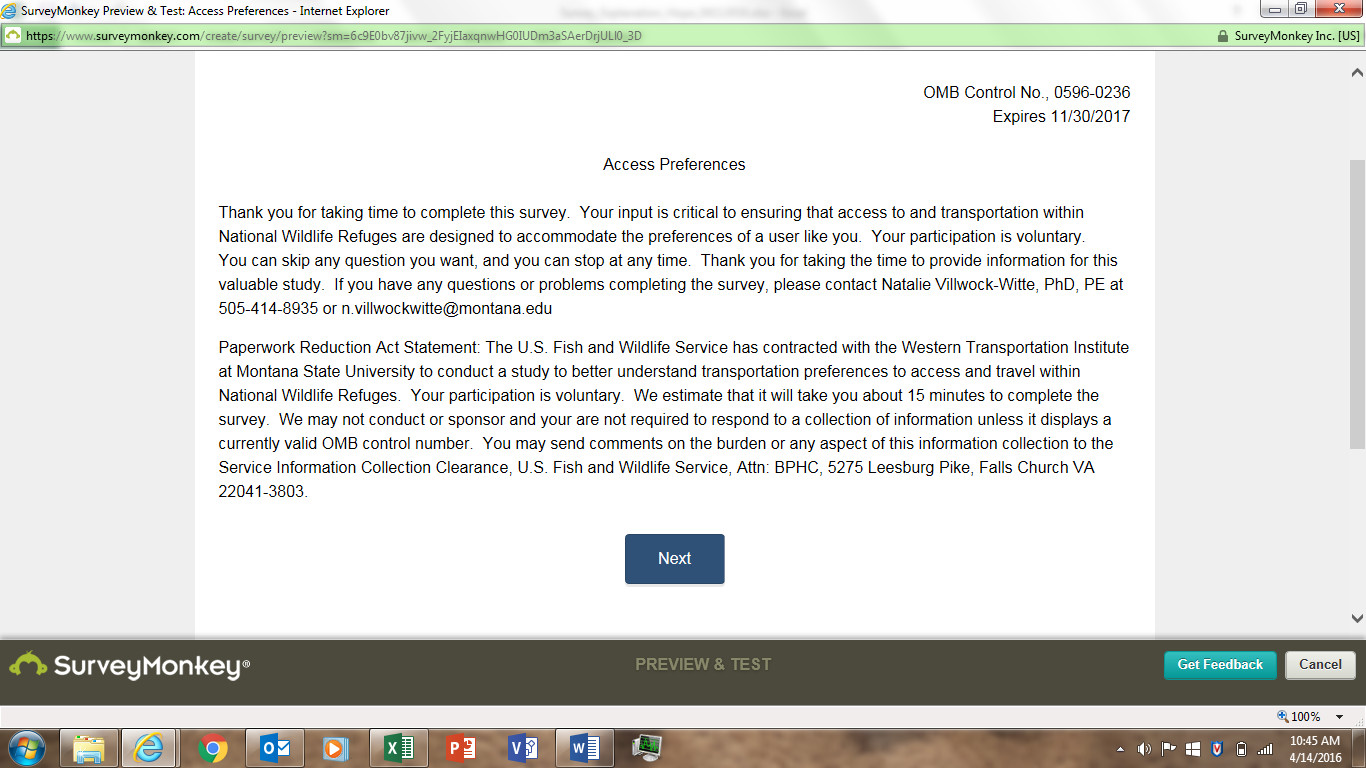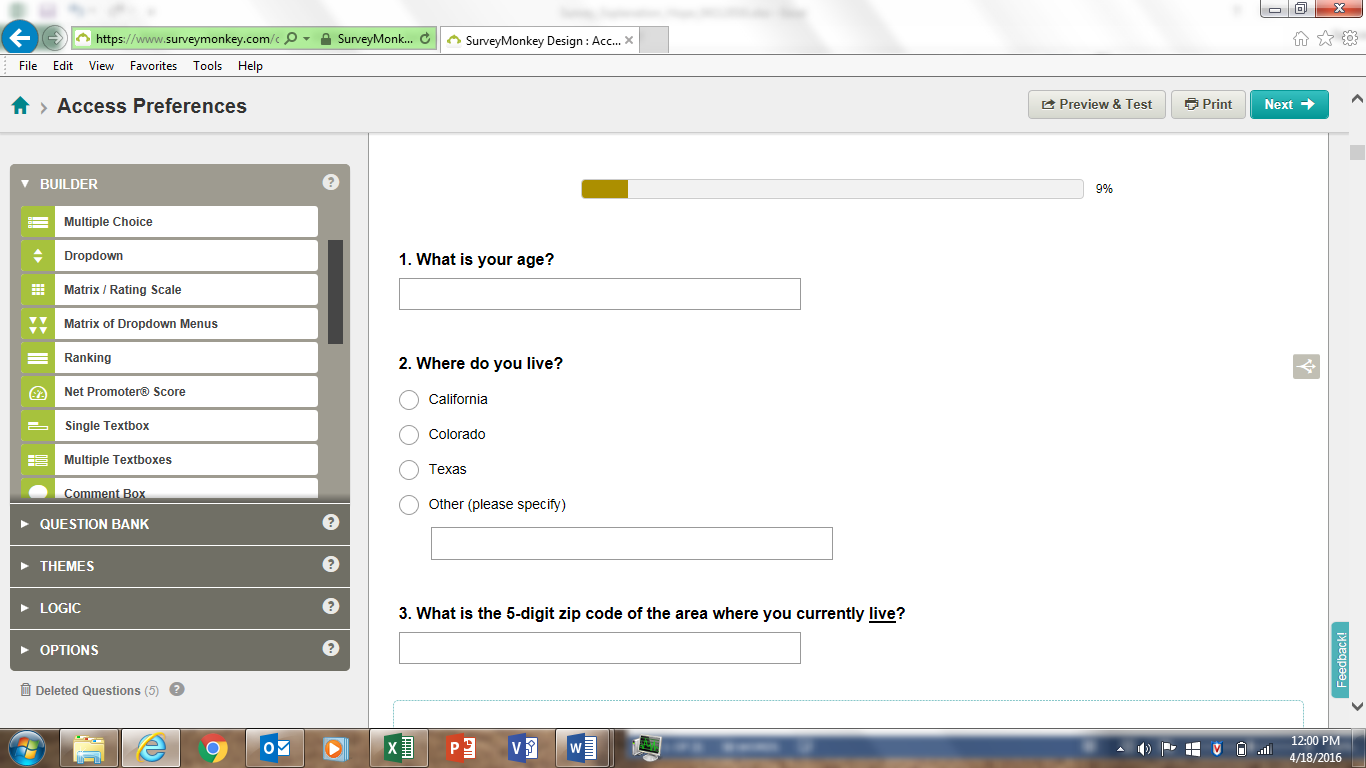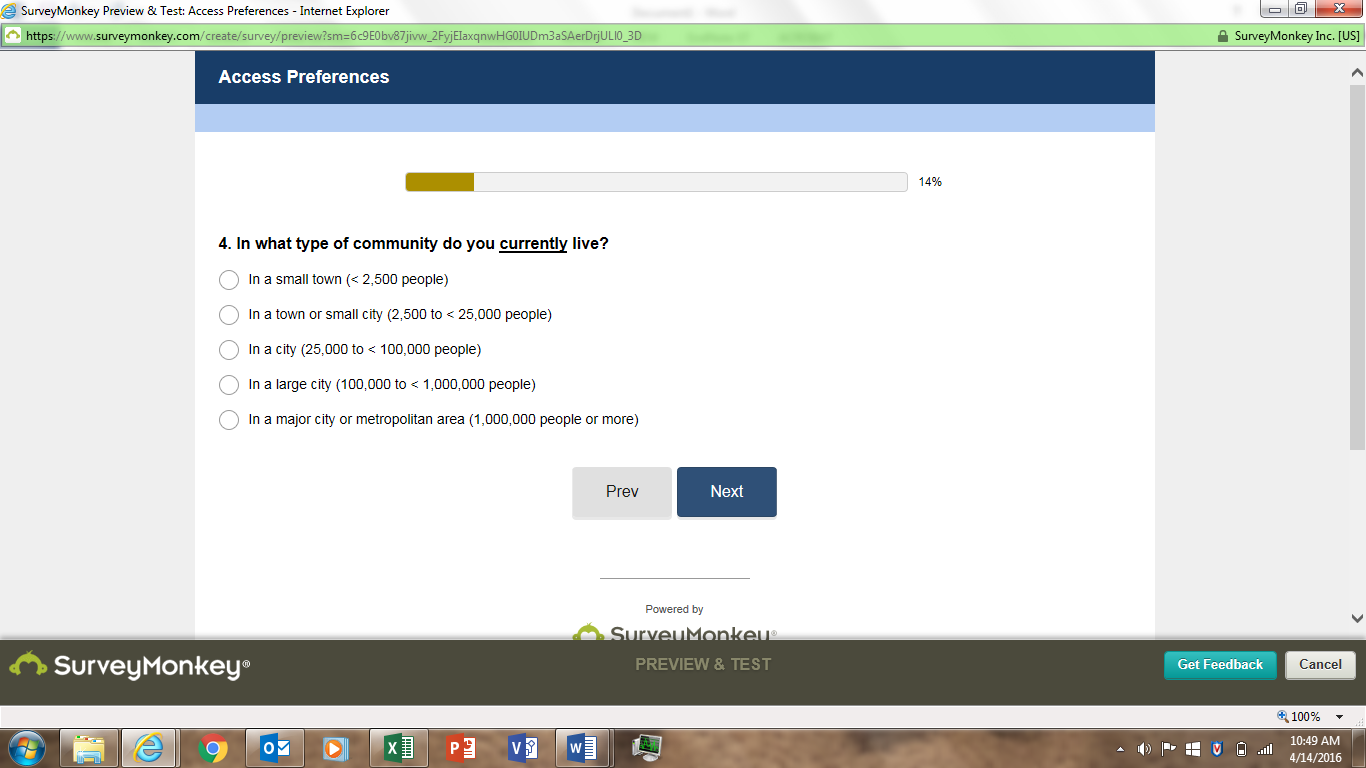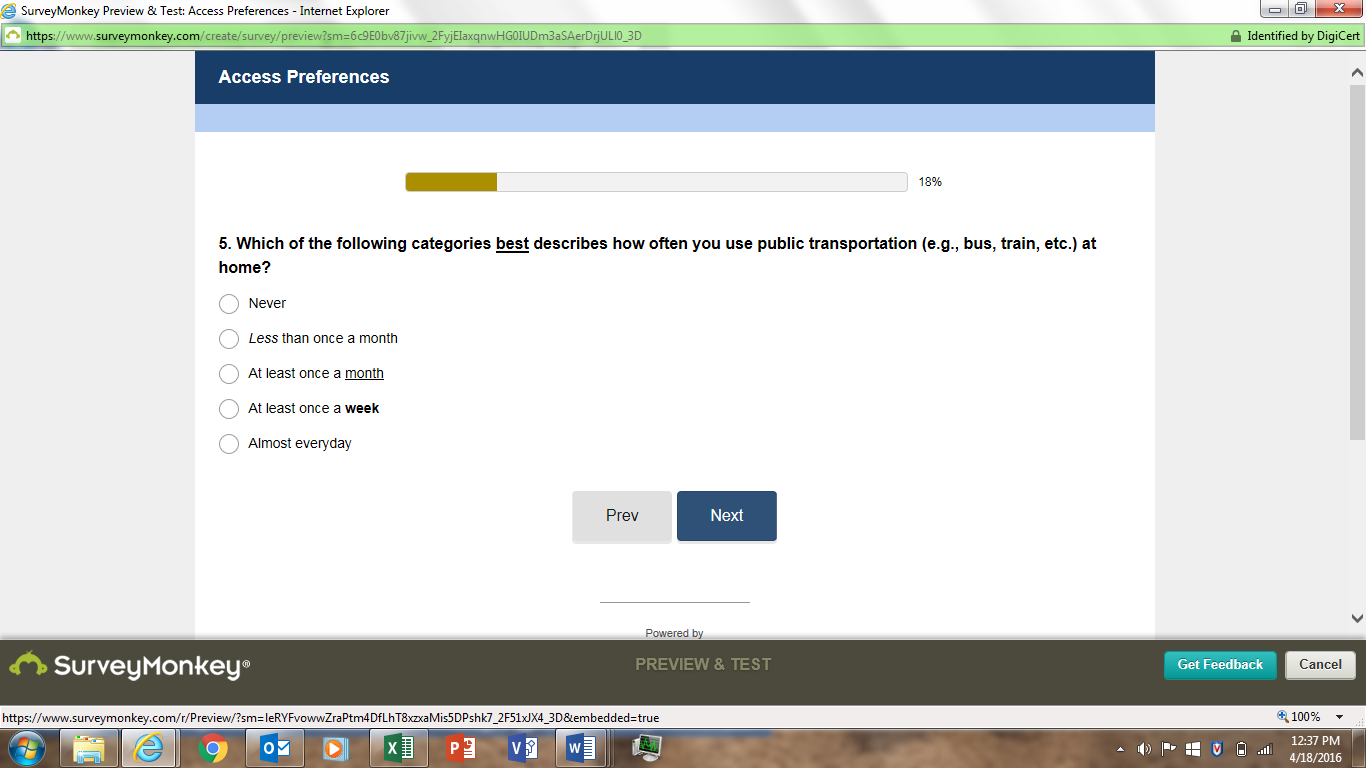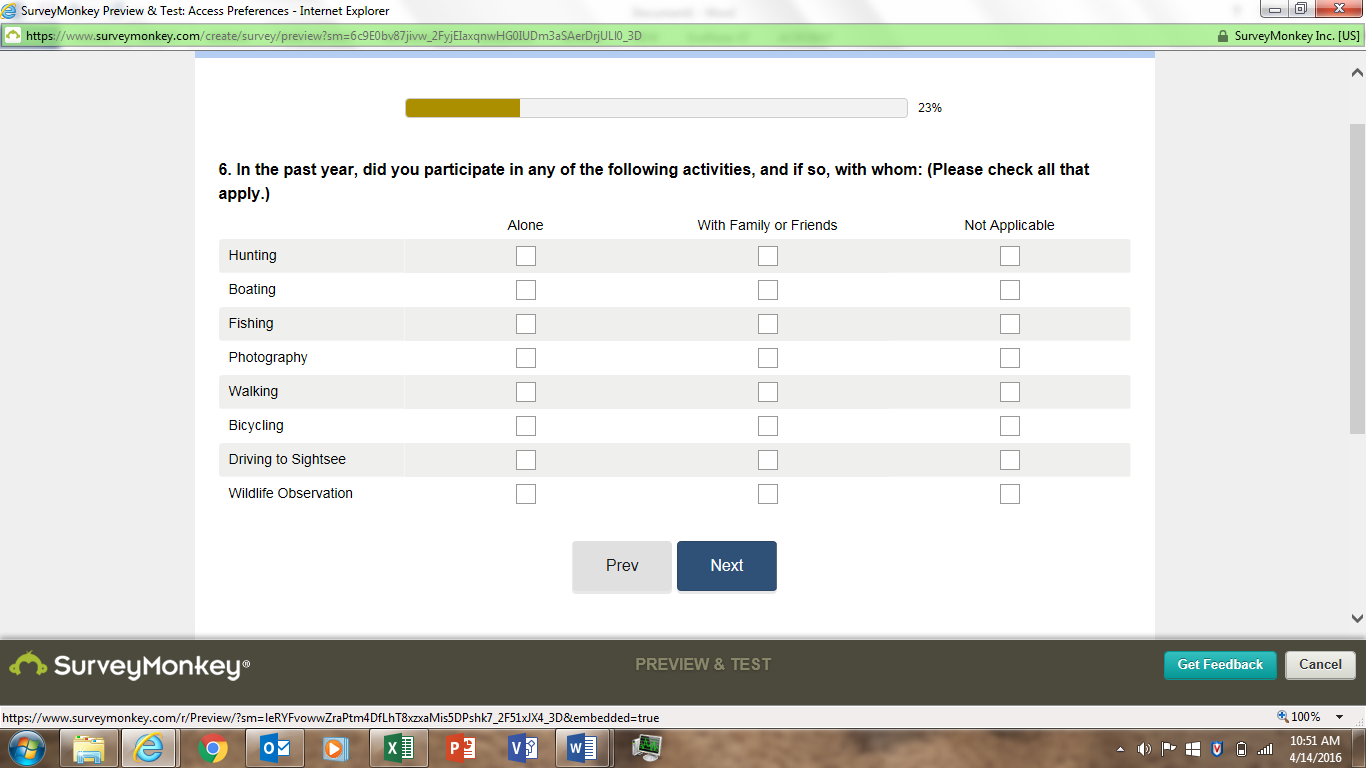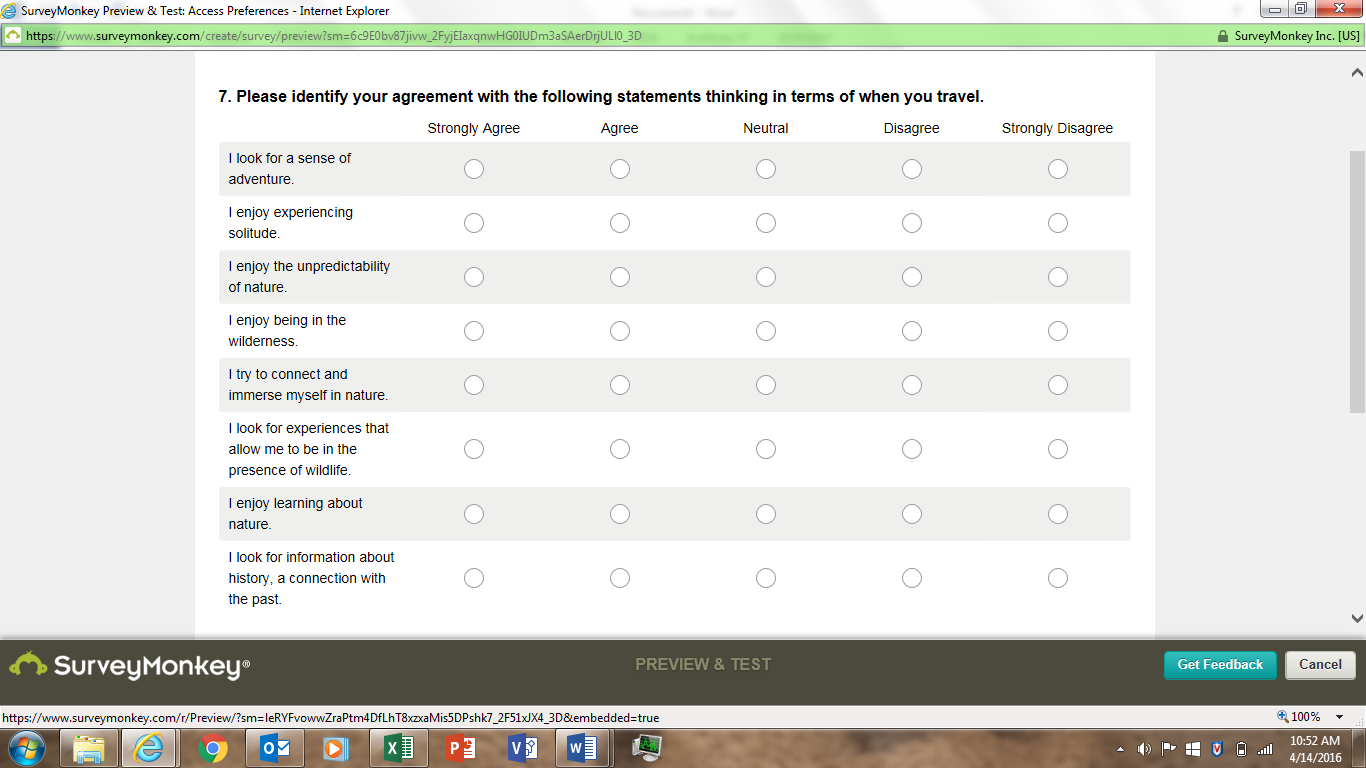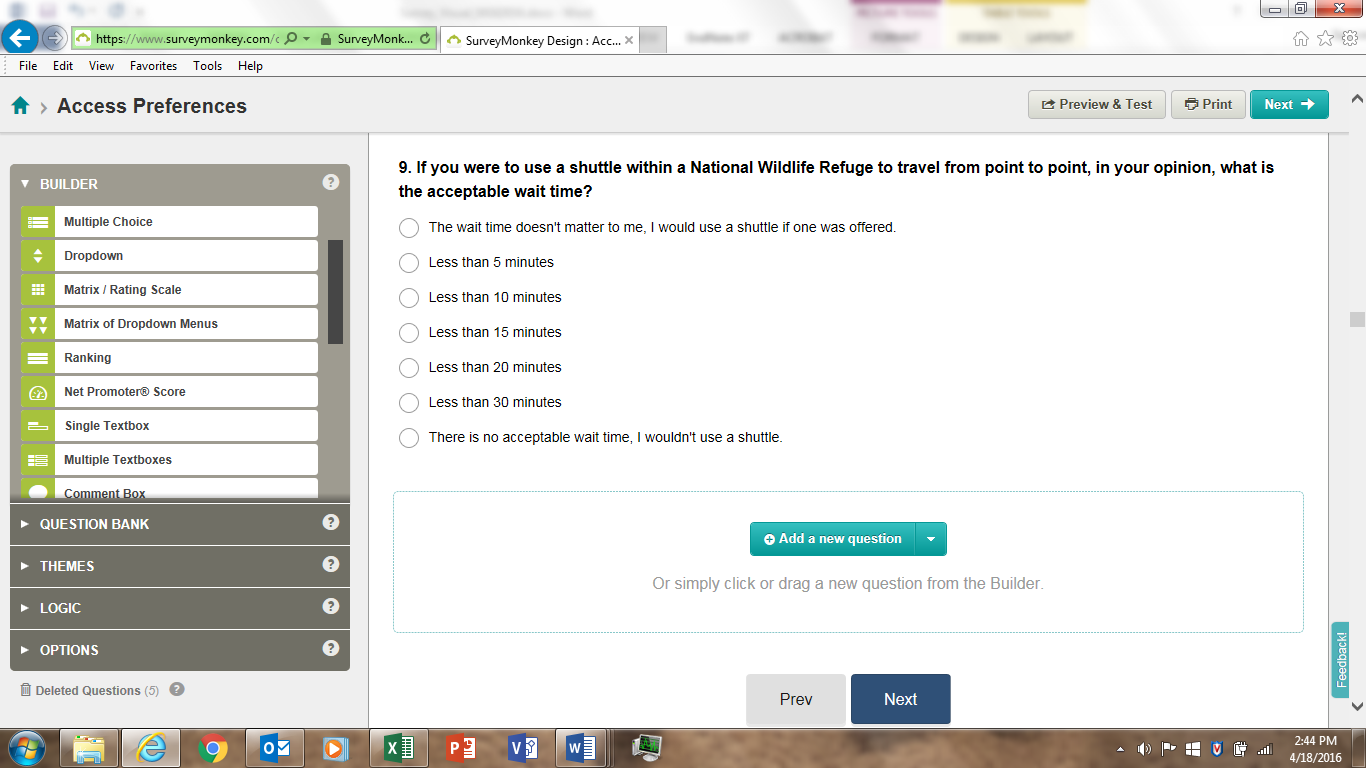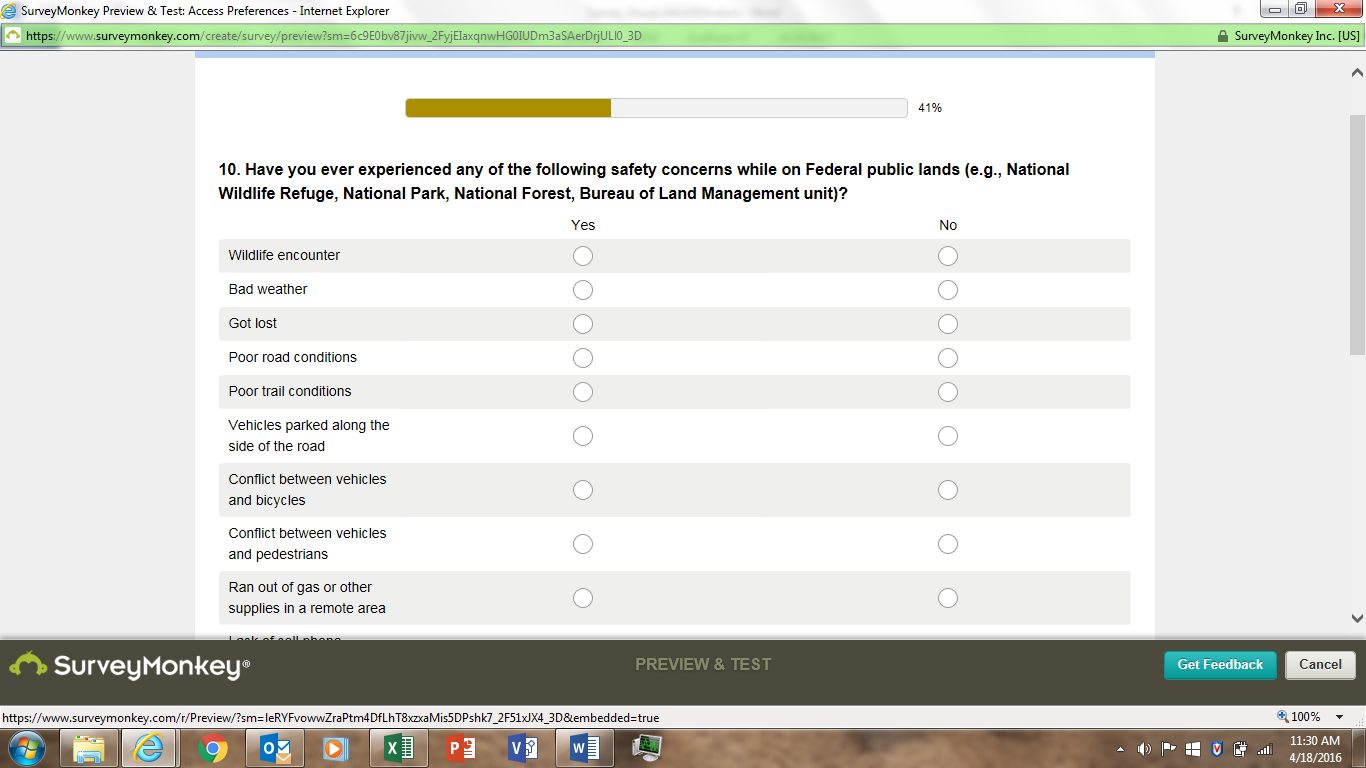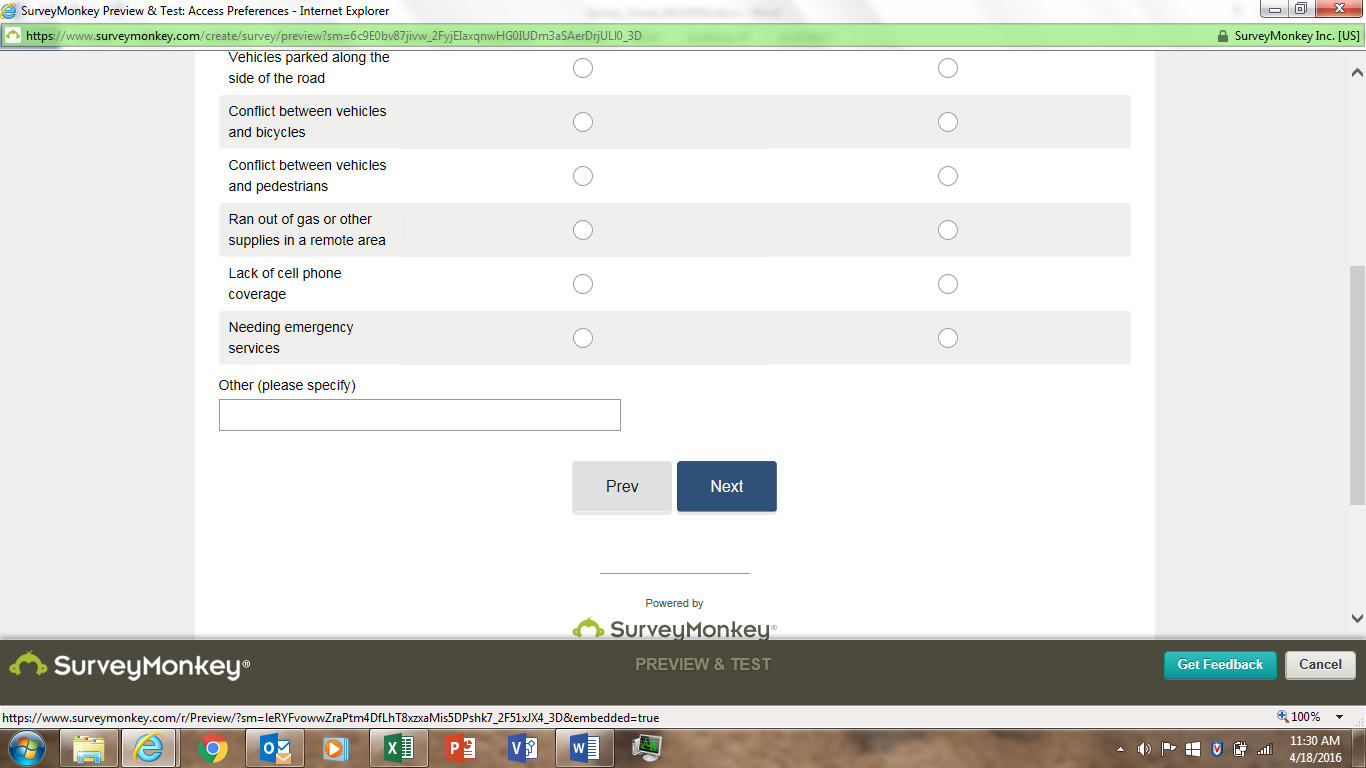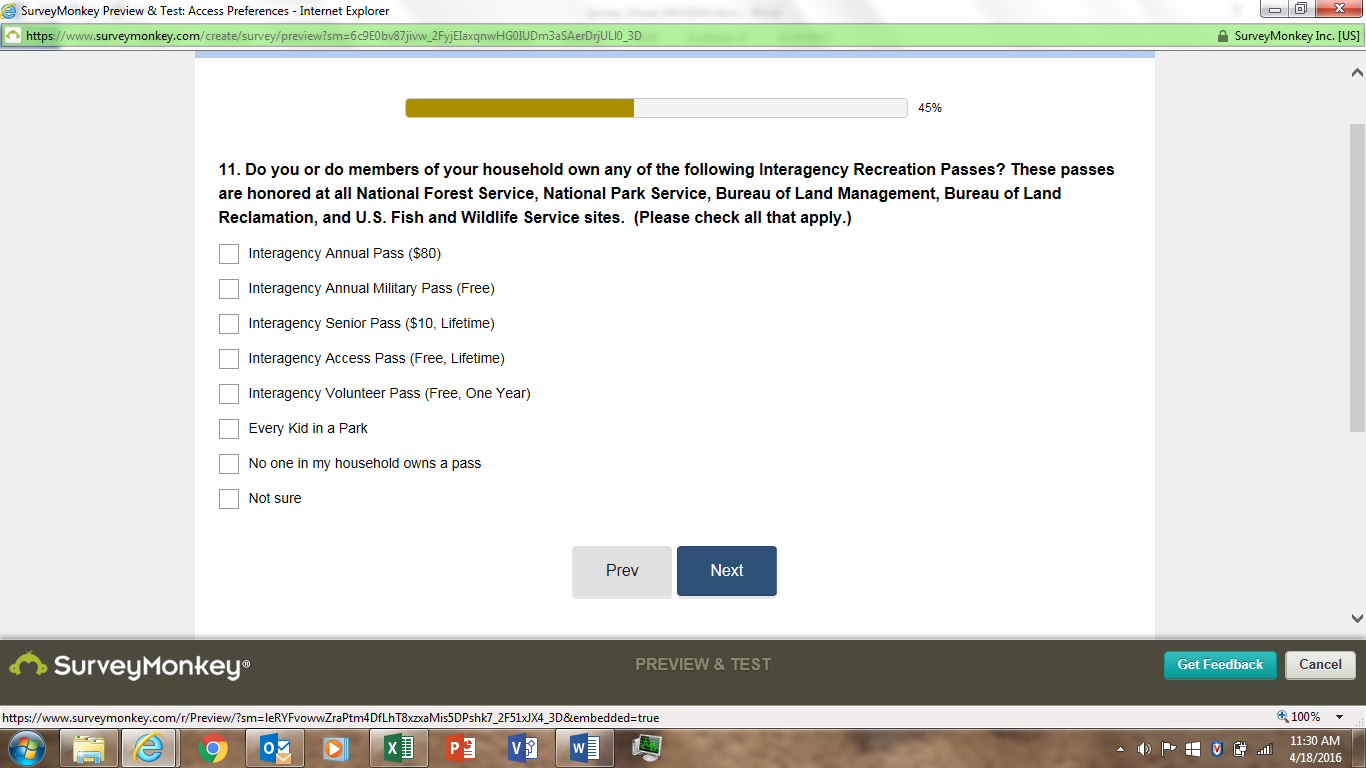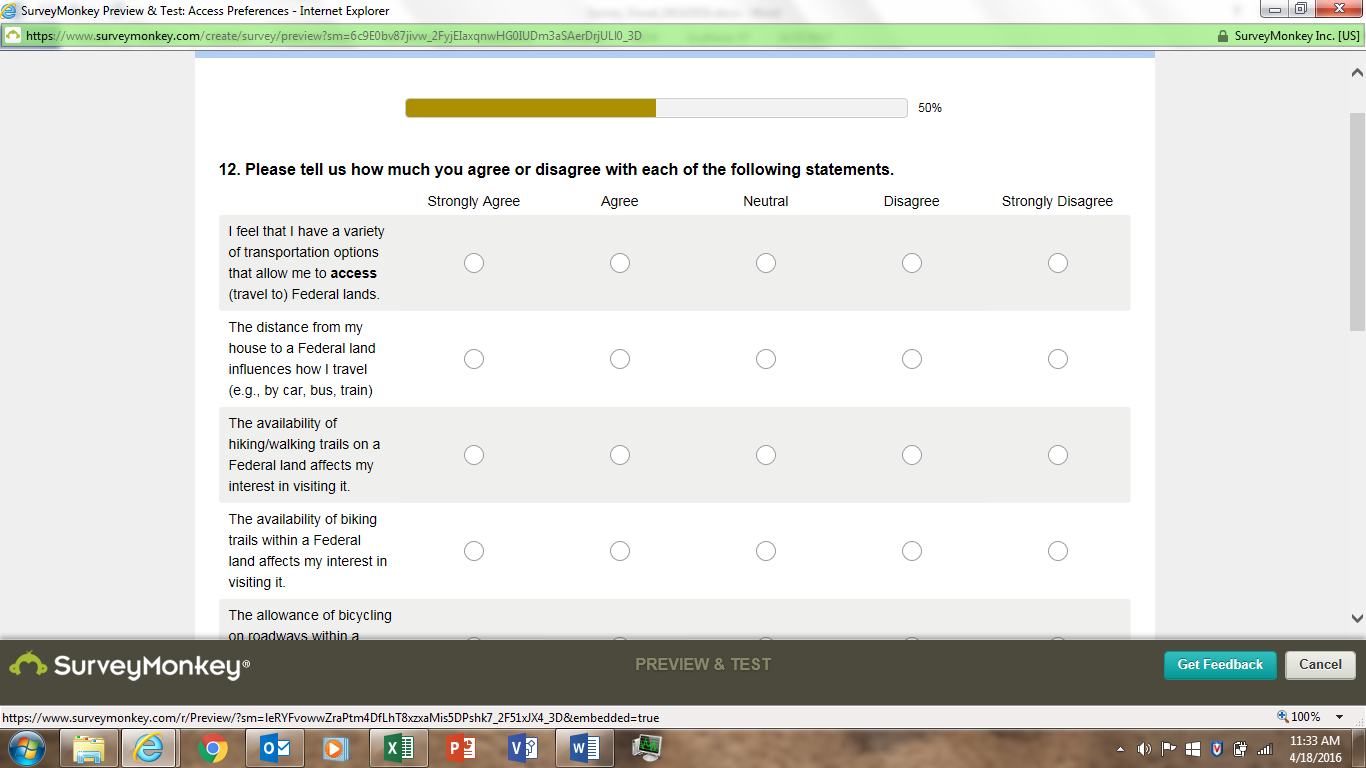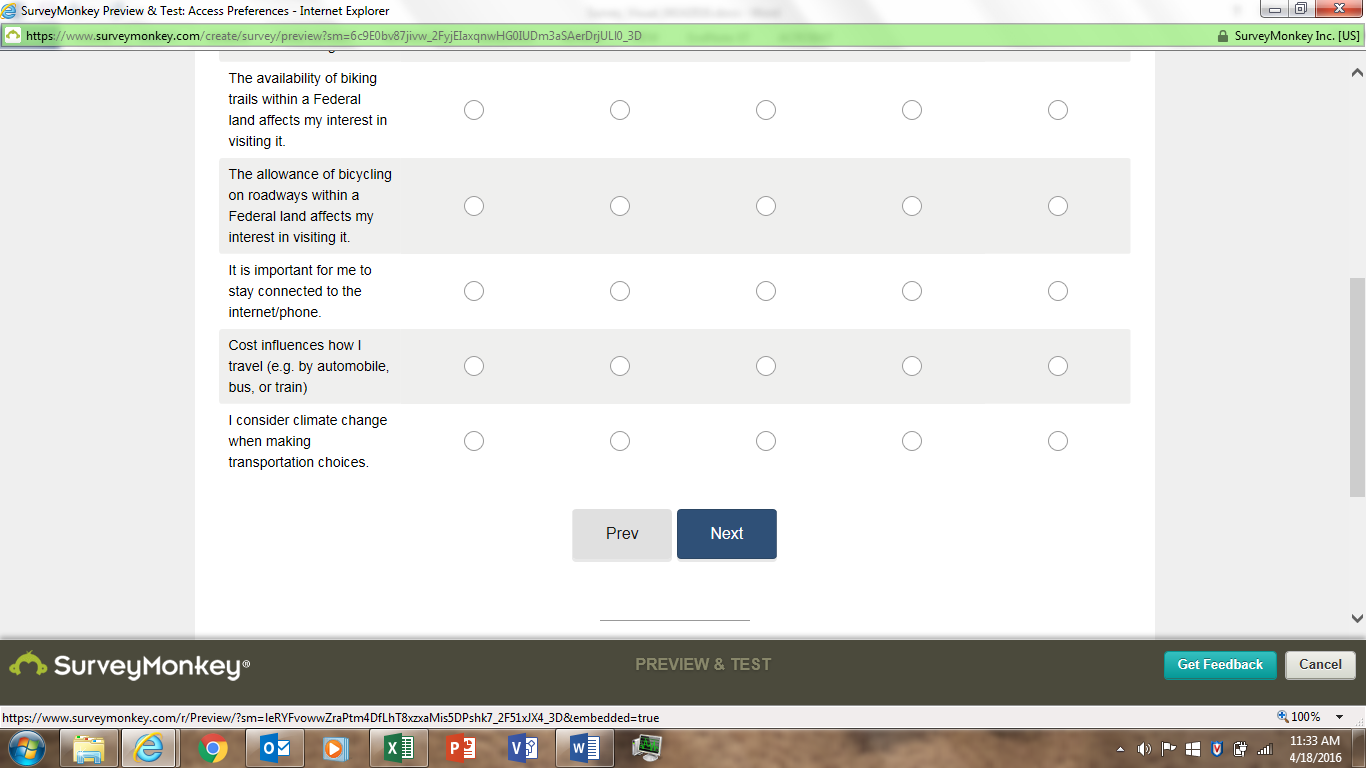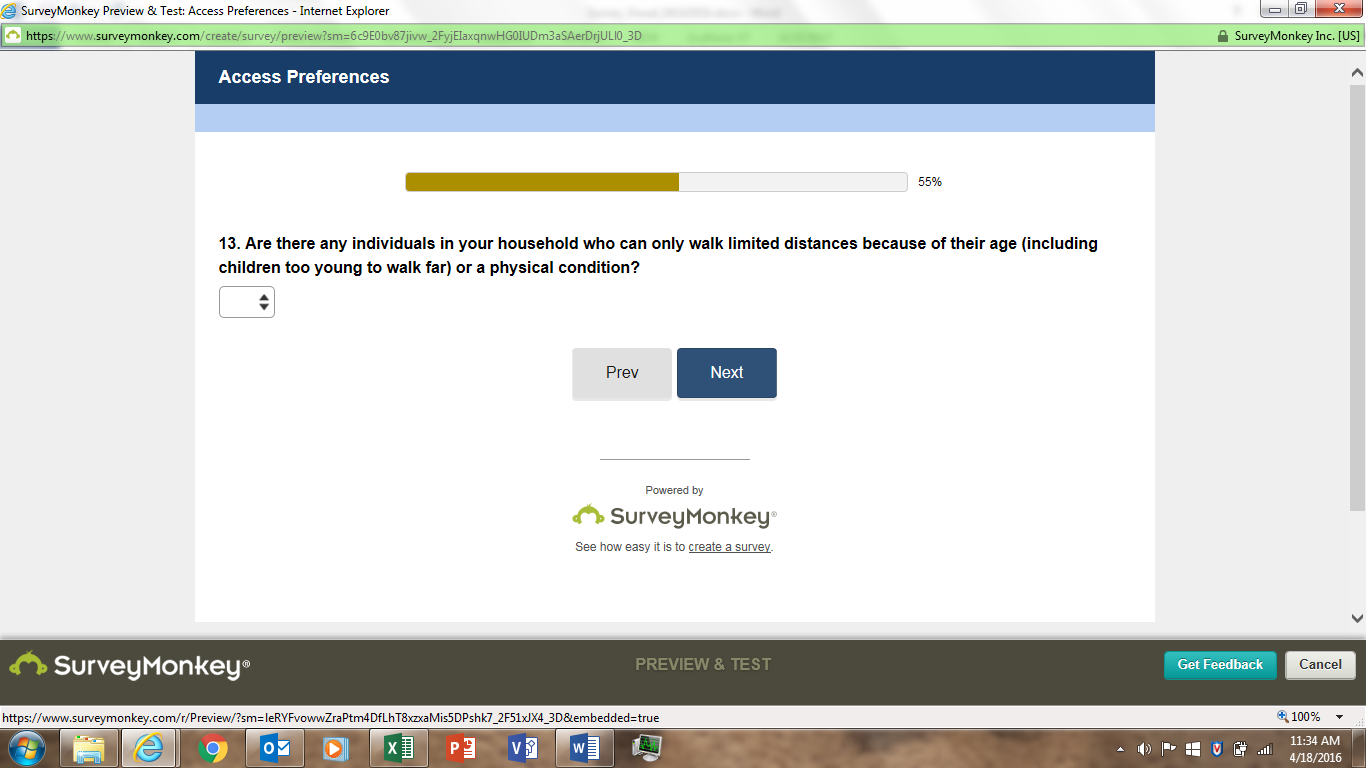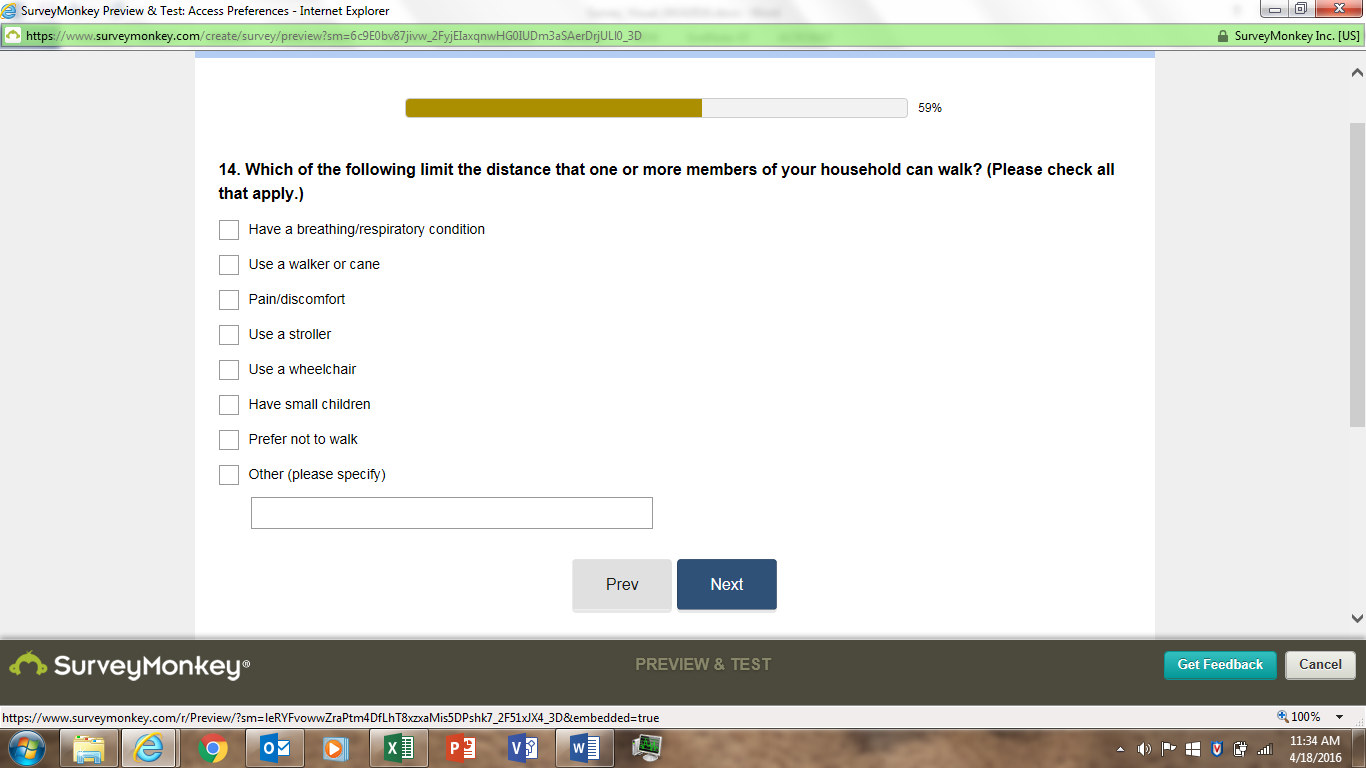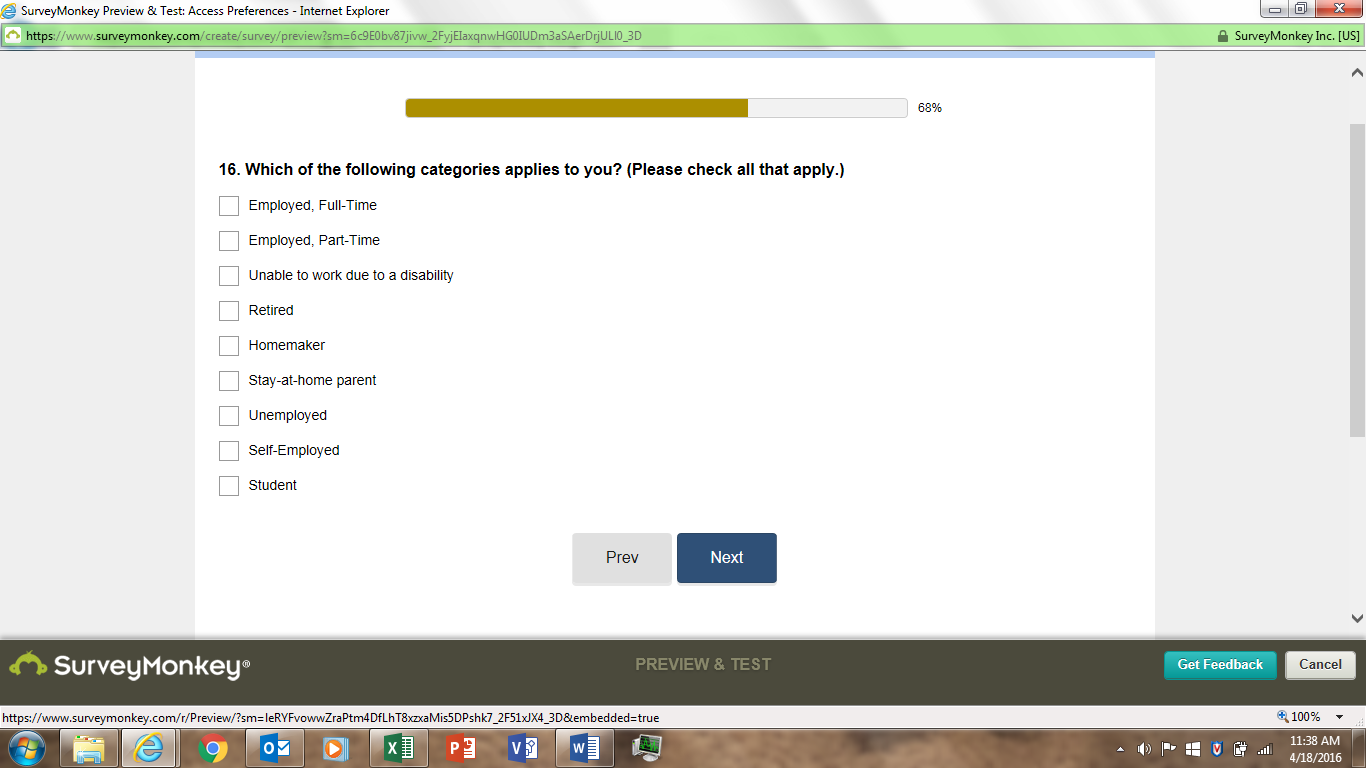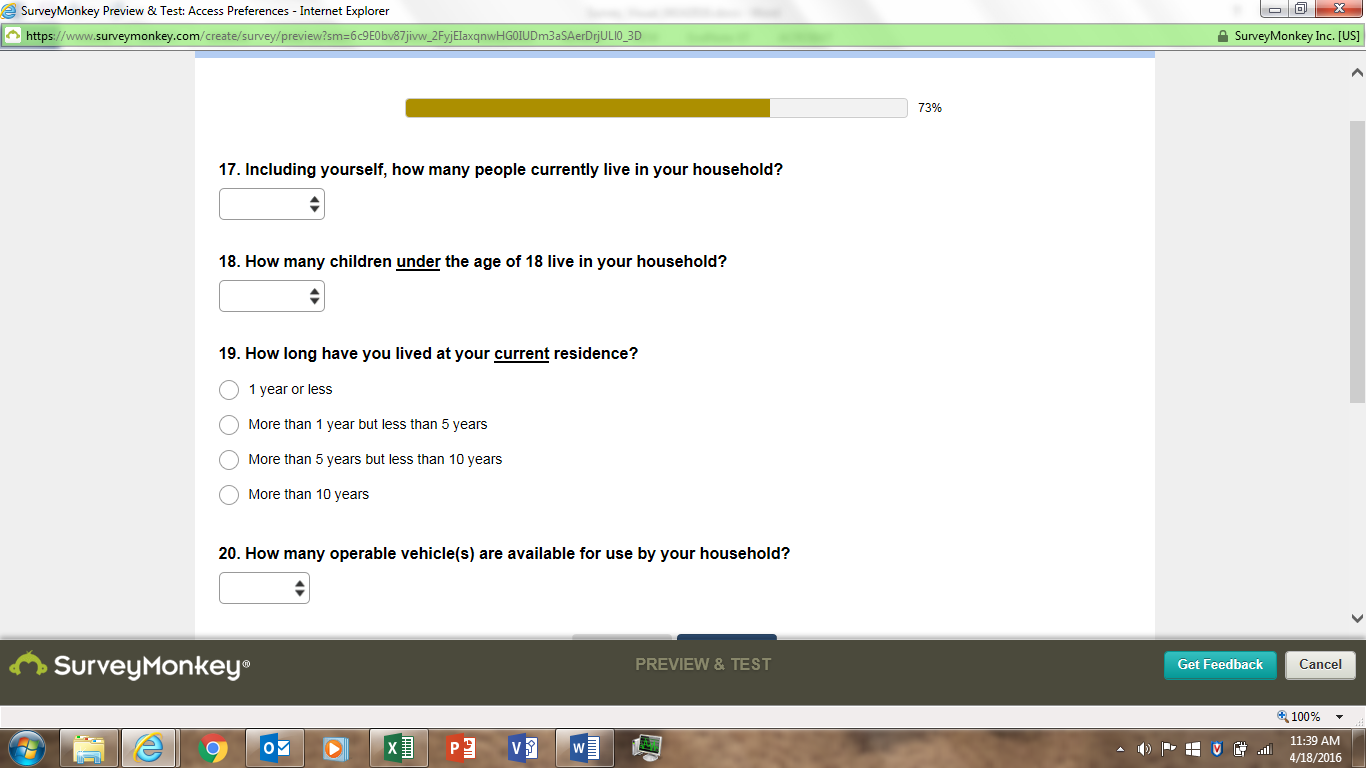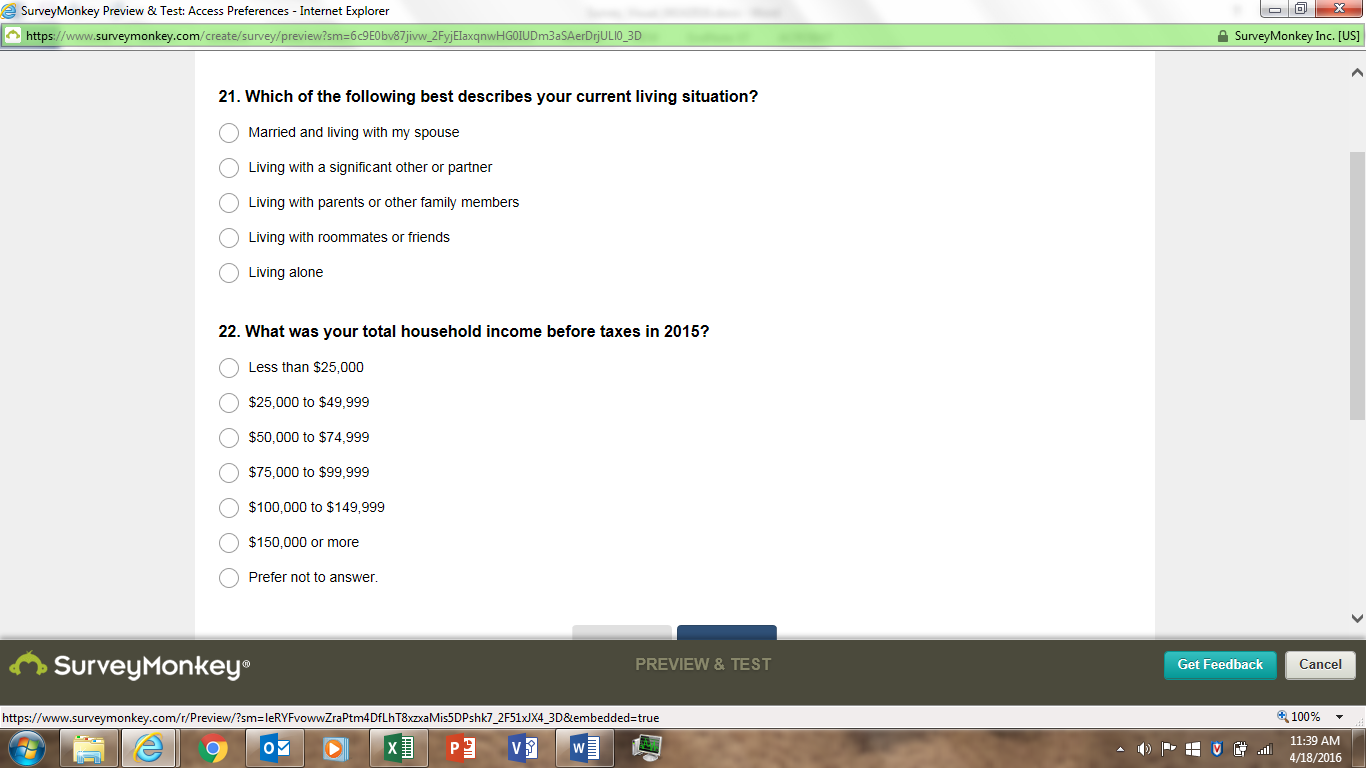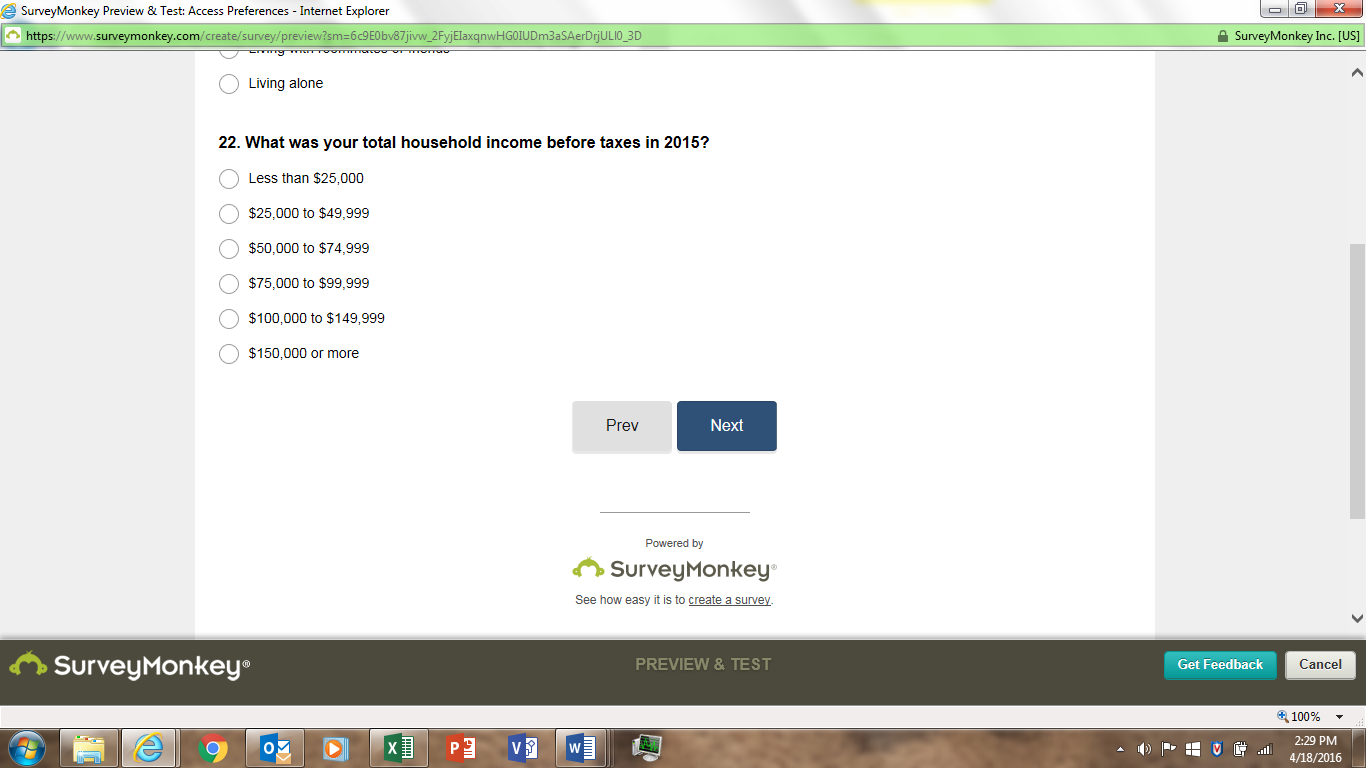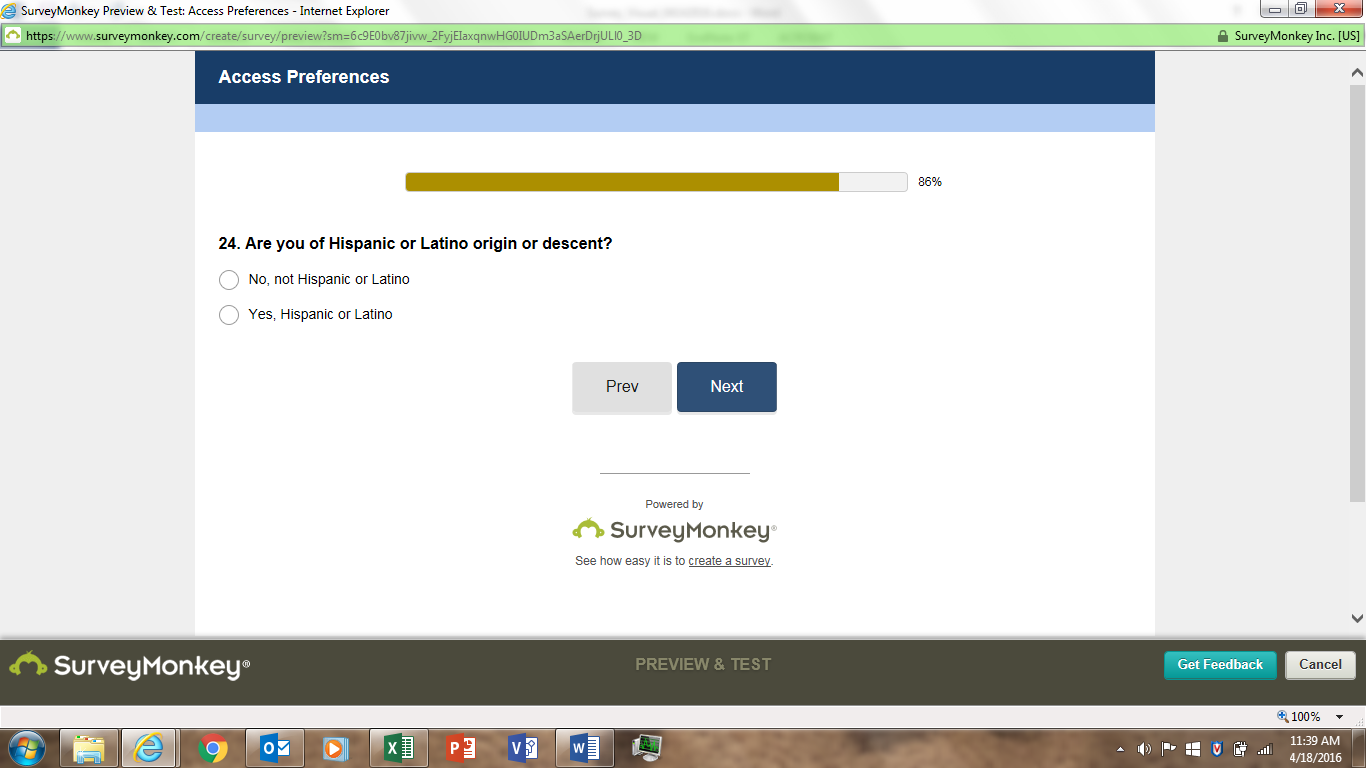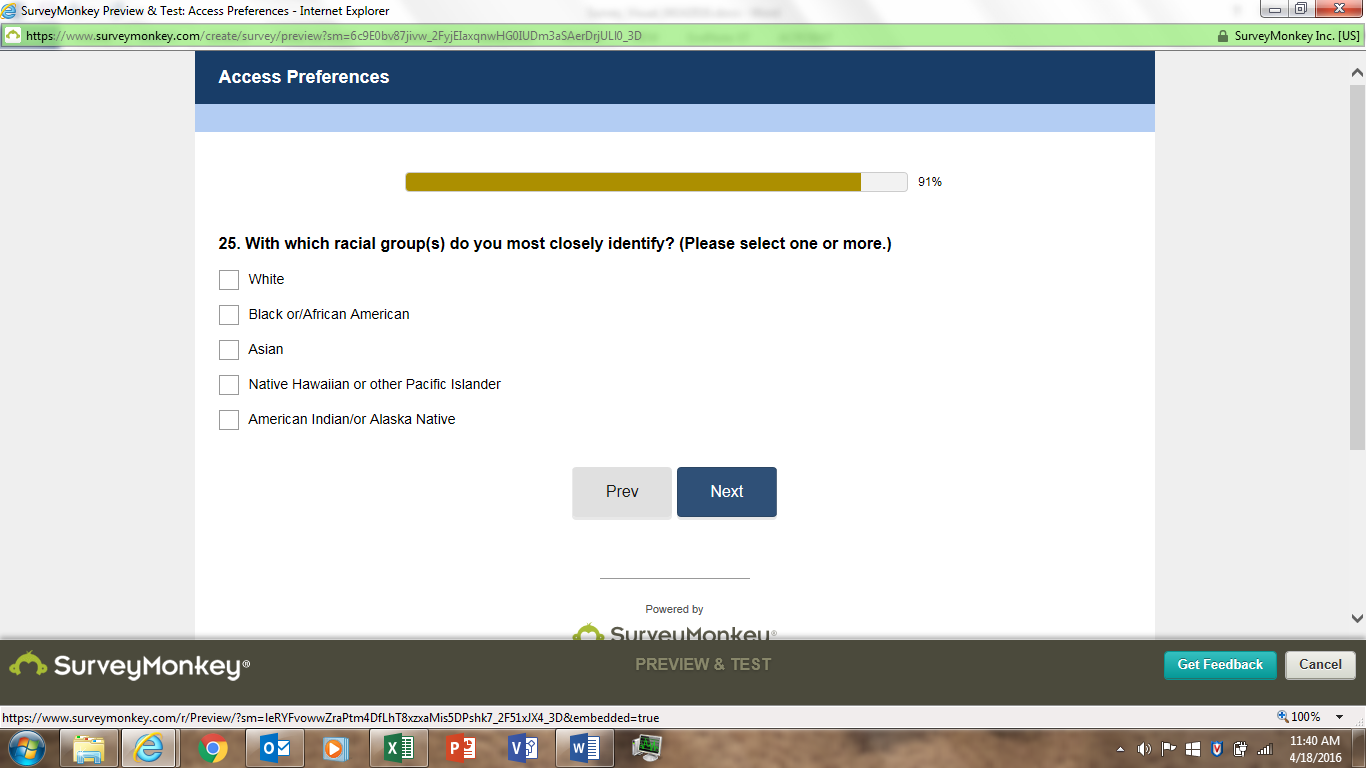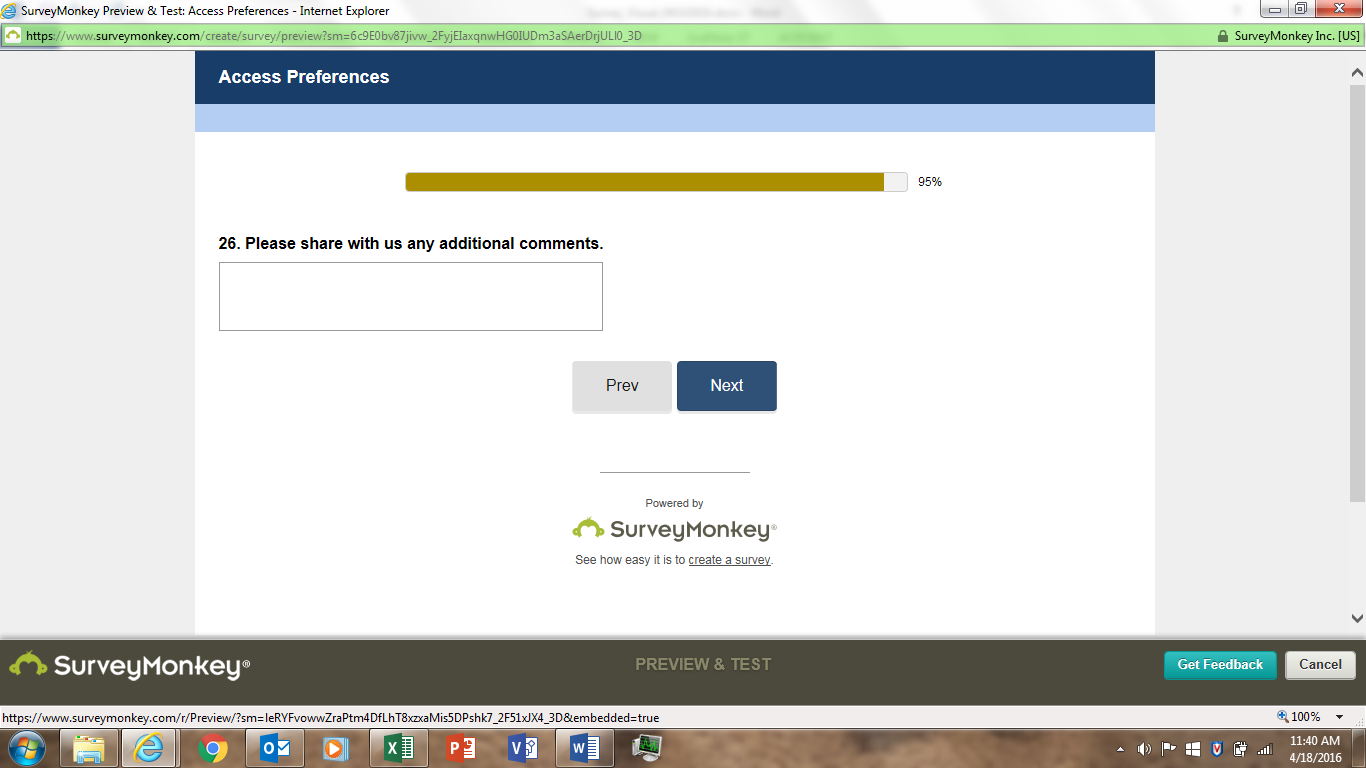Millenial & Baby Boomer Quesiton Matrix
Millennial question matrix.docx
Interagency Generic Clearance for Federal Land Management Agencies Collaborative Visitor Feedback Surveys on Recreation and Transportation Related Programs and Systems
Millenial & Baby Boomer Quesiton Matrix
OMB: 0596-0236
INTRODUCTION |
|
|
n/a |
Survey introduction. |
|
QUESTION 1 |
|
|
AGE1: What is your age? _ Under 18 _18 – 24 _ 25 – 44 _ 45 – 54 _ 55 – 64 _ 65+
|
We removed the categories. Instead, we asking the respondent to type in their age. A significant importance of this study is to understand what generational cohort a respondent fits into. Generational cohorts have some variation, so asking the age instead of providing a category will allow us to understand if one generational definition better explains the responses. |
|
QUESTION 2 |
|
|
n/a |
This is a screening question. It will allow us to filter out potential respondents who are NOT from one of three target states (California, Colorado or Texas). Those choosing “Other” will be directed out of the survey. Additionally, the provider of survey respondents will be directing only individuals that live in these states to this survey, thereby reducing the burden of response. |
|
QUESTION 3 |
|||||||||||||||||||||||||
|
RES1: Where do you live?* City ________ State___ ZIP ___ Country (if not US) ____________
RES2: Do you live in the United States or Canada? _Yes What is your home state/province ___________ What is your zip code/postal code___________
_No What country do you live in? ______________
RES3: Do you live in the United States? _Yes (What is your Zip Code? _____) _No (What country do you live in? ____________)
RES4: For you and your personal group on this visit, please provide the following information. (If you do not know the answer, leave blank.)
RES5: Are you a permanent resident or citizen of the U.S.? _No ― What is your country of origin? ____ _Yes ― What is your zip code and state of residence? Zip Code ___ State ______________
RES6: In which village or town do you live? ____ What is your home zip code? _____
RES7: Home postal or ZIP code: __________ (write in)
|
||||||||||||||||||||||||
This question is most like RES6. However, as shown on the right, there are many variations of questions that ask about one’s zip code. Our question just re-iterates that we’re looking for five digits and to clarify that it’s were the respondent currently lives, not the zip of where they’re at the time they are responding to the survey. |
|||||||||||||||||||||||||
QUESTION 4 |
|
|
RES15: In what type of community do you now live? _In a small town (less than 2,500) _In a town or small city (between 2,500-25,000 people) _In a city (between 25,000 and 100,000 people, _In a large city (100,000 to 1 million people) _In a major city or metropolitan area (over 1 million people)
|
We reduced the burden of the respondent by using visual “<” as compared with “less than.” In addition, we added consistency to the categories by always having the second one be < or equal to the number (compare “In a large city”). |
|
QUESTION 5 |
|
|
TRANSIT1: How often do you use public transportation at home? _Never _Hardly ever _At least once a month _At least once a week _Almost everyday
|
Hope requested that we better define "Hardly Ever" as listed in the original approved question. This category is expected to represent riders who know how to use transit, but rarely do. We also underlined month and bolded week to ease the burden on the respondent by more clearly conveying that they were different time frames (month vs. week)
|
|
QUESTION 6 |
|||||||||||||||||||||||||||||||||||||||||||||||||||||||||||||||||||
|
TACT1: In which of the following activities have you participated or will you participate during this [site] visit? Nonmotorized activities: _Hiking or Walking _Horseback riding _Bicycling, including mountain bikes _Nonmotorized water travel (canoe, sailing, raft, etc.) _Downhill skiing or snowboarding _Cross-country skiing, snowshoeing _Other nonmotorized activities (swimming, games, and sports) Motorized Activities: Motorized activities: _Driving for Pleasure on roads (paved, gravel, or dirt) _Riding on motorized trails (non-snow) _Riding in designated off road vehicle areas (non-snow) _Snowmobile travel _Motorized water travel (boats, ski sleds, etc.) _Other motorized activities (endure events, games, planes, etc.)
TACT2: Which of the following activities did you [/will you] do during this trip to [site]? Check one box for each item. NOTE: If survey is administered during the trip (vs. after the trip has been completed), FLMAs may want to include the reference to future activities (“will you”) and add a column “Will do on this trip.”
b) Which of the activities listed in Question X is your primary activity on this trip to [X]? (Enter Letter of primary box or check the box) Letter of primary activity: ___
TACT3: What activities did you participate in during your most recent visit to this [site]? (please mark all that apply) _ Hunting If you marked hunting, please mark what type below. __ Big game __ Small game __ Waterfowl _ Boating (including canoes / kayaks) _ Environmental education (for example, classrooms or labs, tours) _ Special event (please specify) _ Fishing _ Photography _ Interpretation (for example, exhibits, kiosks, videos) _ Hiking _ Bicycling _ Auto Tour Route/Driving _ Wildlife observation Please mark if you were bird-watching. __ Bird watching _ Other (please specify)
TACT7: Please look at the activity list below and circle the three main activities you have participated in [on the lake] in the past four weeks.
[include area-specific list of activities, e.g., backpacking, camping, canoeing or kayaking, sailing, wildlife observations & photography, horseback riding, picnicking, collecting berries, mushrooms, and so forth, visiting historic areas, sites, buildings, or memorials, etc.)
TACT8: Please tell us how many times during the past 12 months you have used the following public facilities in [Alaska]?
|
||||||||||||||||||||||||||||||||||||||||||||||||||||||||||||||||||
This question is similar to a number of questions as shown. The cross-tabulation format will allow us to compare types of activities with the type of party (alone, family/friends, not applicable). Millennials were reported in the literature to prefer to travel with family and friends instead of alone.
|
|||||||||||||||||||||||||||||||||||||||||||||||||||||||||||||||||||
QUESTION 7 |
|||||||||||||||||||||||||||||||||||||||||||||||||||||||||||||||||||||||||||||||||||||||||||||||||||||||||||||||||||||||||||||||||||||||||||||||||||||||
|
RESPRO1: The following questions ask about various components of your [site] visit. Circle one response each in columns 1 and 2)
|
||||||||||||||||||||||||||||||||||||||||||||||||||||||||||||||||||||||||||||||||||||||||||||||||||||||||||||||||||||||||||||||||||||||||||||||||||||||
RESPRO1 was modified so that it doesn’t have to reflect someone visiting a site, as these questions will be asked of the general population in 3 target states. We are asking for their level of agreement, like that shown in RESPRO1. |
|||||||||||||||||||||||||||||||||||||||||||||||||||||||||||||||||||||||||||||||||||||||||||||||||||||||||||||||||||||||||||||||||||||||||||||||||||||||
QUESTION 8 |
|||||||||||||||||||||||||||||||||||||||||||||||||||||||||||||||||||||||||
|
OPIN5: Below are different alternative transportation options that could be offered at some national [wildlife refuges] in the future. Considering [refuges] you have visited, please tell us how likely you would be to use each transportation option.
|
||||||||||||||||||||||||||||||||||||||||||||||||||||||||||||||||||||||||
Same as OPIN5. |
|||||||||||||||||||||||||||||||||||||||||||||||||||||||||||||||||||||||||
QUESTION 9 |
|
|
SHPREF23: In your opinion, what is the acceptable wait time for shuttles within [site]? _The wait time doesn’t matter to me. _The acceptable wait time in minutes is: -Less than 5 minutes -Less than 10 minutes -Less than 15 minutes -Less than 20 minutes -Less than 25 minutes -Less than 30 minutes -Less than 35 minutes -Less than 40 minutes
SHPREF24: In your opinion, what is the maximum wait time the [agency] should allow for a roadside shuttle? _The wait time doesn’t matter to me. The maximum wait time in minutes that should be allowed by [agency]. -Less than 5 minutes -Less than 10 minutes -Less than 15 minutes -Less than 20 minutes -Less than 25 minutes -Less than 30 minutes -Less than 35 minutes -Less than 40 minutes
SHPREF25: : In your opinion, what amount of time would be so unacceptable that you would no longer wait for a shuttle within [site]? _The wait time doesn’t matter to me. The maximum wait time before I no longer wait. -Less than 5 minutes -Less than 10 minutes -Less than 15 minutes -Less than 20 minutes -Less than 25 minutes -Less than 30 minutes -Less than 35 minutes -Less than 40 minutes
SHPREF31: Which of the below service frequencies would you prefer for the [X] shuttle? (Select one) _ There is less than 10 minutes between bus departures from each stop. _ A bus departs from each stop every 10 to 14 minutes. _ A bus departs from each stop every 15 to 20 minutes. _ A bus departs from each stop every 21 to 30 minutes. _ A bus departs from each stop every 31 to 60 minutes. _ There is more than one hour between bus departures from each stop OR _ None of the service frequencies are so unacceptable that I would no longer use the [Mount Rainier] shuttle.
|
We’ve added the counter response to “The wait time doesn’t matter to me.” to identify those that would never consider using a shuttle.
|
|
QUESTION 10 |
|
|
SAFE8: Have you ever experienced any safety concerns on Federal public lands as a result of the following issues or events? Yes No
IF YES TO ANY ITEMS: Please describe: (Open-ended)
|
We’ve added a “No” for each “safety concern.” We’ve removed the burden of describing the safety concern as requested in the original question. |
|
QUESTION 11 |
|
|
TPLAN9: Do you or do members of your group own any of the following Interagency Recreation Passes? These passes are honored at all National Forest Service, National Park Service, Bureau of Land Management, Bureau of Land Reclamation, and U.S. Fish and Wildlife Service sites. (Check all that apply)
_Interagency Annual Pass ($80) _Interagency Annual Military Pass (Free) _Interagency Senior Pass ($10, Lifetime) _Interagency Access Pass (Free, lifetime) _Interagency Volunteer Pass (Free, one year) _No one in my group owns a Pass _Not sure
|
We’ve added “Every Kid in a Park,” a Interagency Recreation Pass that did not exist when this question was drafted. |
|
QUESTION 12 |
|||||||||||||||||||||||||||||||||||||||||||||||||||||||||||||||||||||||||||||||||||||||||||||||||
|
RESPRO7: To what extent do you disagree or agree with each statement below regarding climate change as it relates to fish, wildlife and their habitats?
|
||||||||||||||||||||||||||||||||||||||||||||||||||||||||||||||||||||||||||||||||||||||||||||||||
This question is best described as a conglomeration of other questions found in the Compendium; however, it is simplified to reduce the burden on the respondent. |
|||||||||||||||||||||||||||||||||||||||||||||||||||||||||||||||||||||||||||||||||||||||||||||||||
QUESTION 13 |
|
|
GROUP12: Are there any individuals in your immediate travel party who can only walk limited distances because of their age or a physical condition? __ Yes __ No [If yes]: Which of the following limit the distance that one or more members of your group can walk? (Check all that apply) _pain/discomfort _use a wheelchair _use a walker or cane _use a stroller _have a breathing/respiratory condition _have small children _prefer not to walk _other
|
Same as GROUP12. |
|
QUESTION 14 |
|
|
GROUP12: Are there any individuals in your immediate travel party who can only walk limited distances because of their age or a physical condition? __ Yes __ No [If yes]: Which of the following limit the distance that one or more members of your group can walk? (Check all that apply) _pain/discomfort _use a wheelchair _use a walker or cane _use a stroller _have a breathing/respiratory condition _have small children _prefer not to walk _other
|
Same as GROUP12. |
|
QUESTION 15 |
|
|
GEN1: What is your gender? Please mark (•) one. _ Male _ Female _ Other (OPTIONAL Response Category)
|
The same as GEN1. |
|
QUESTION 16 |
|
|
EMP1: What is your current employment status? _Full-time employed _Part-time employed _Not employed outside the home _Full time student _Not currently employed
EMP2: Which one of the following best describes your employment situation? _Working full-time for pay _Working part-time for pay _Self-employed/consultant _Currently seeking work/unemployed _Retired _Permanently disabled _Homemaker/caregiver _Student _Other
EMP3: Which of the following categories applies to you? (please check all that apply)
_Employed full-time _ Retired _Unemployed _Student _Employed part-time _Homemaker _Self-employed
|
We’ve added “Unable to work due to disability,” which is a Social Security approved description. We’ve also added “Stay-at-home parent” which reflects that some people stay home to care for their children (e.g., a father), yet they do not view themselves as a “Homemaker.” This is a very traditional term and based on the primary audience of the survey, Millennials, would likely result in response refusals. |
|
QUESTION 17 |
|
|
HOU2: Including yourself, how many people live in your household?* __
|
We’ve added a drop down of numbers from 1 to More than 6. This should ease the burden of response. |
|
QUESTION 18 |
|
|
HOU4: How many children under the age of 18 are living in your household? _None _One _Two _Three _Four _Five _Six _More than six
|
The questions are the same, except that we added an underline for “under” and we used numbers instead of the written number (0 vs. None). |
|
QUESTION 19 |
|
|
n/a |
We are looking at generations, and in particular, Millennials and a sub-group of Baby Boomers that have moved west after they retired. They have been called the “Silver Tsunami.” Therefore, we want to know if a respondent is a Baby Boomer and if they have recently moved. As a result, we have added the above question. |
|
QUESTION 20 |
|
|
GROUP6: On [Survey Date] at the time you were surveyed, you indicated that [N People] person(s) including yourself were traveling in the vehicle. Did any other persons, traveling in other vehicles, visit [site] with you that day? _Yes _No a) How many additional persons? _____ b) In how many different vehicles, did these additional persons travel when they visited this lake with you that day? ___
GROUP7: How many people (including you) traveled here in the same vehicle as you? ___ How many of those people are less than 16 years old? ___
TRANUSE2: On this visit, which forms of transportation did you and your personal group use to arrive at [site or site area]? Please mark (●) all that apply.* _ [area-specific list of transportation options (walk, private vehicle, etc.] _Other (Please specify)
TRANUSE3: How did you get to this [site] today? _ By Car _ By Foot _ By bicycle _ By Train _ City Bus/Metro _ Other
TRANUSE4: How did you reach [site name]? (check only one) _ In a car _ On motorcycle _ In a truck (including 4-wheel drive) _On foot _ In a van _On bicycle _In a motorhome _ Other (specify)
TRANUSE5: How did you get to the start of this activity from where you stayed last night? (Choose one) _ Walk _ Bicycle _ Private vehicle _ Vanpool as an organized group _ Shuttle van/bus (scheduled service) _ Taxi or on-demand shuttle/van _ Other (specify)______
TRANUSE6: On this visit, if you have plans to go back into [site], how will you get there? _Will not be going back OR (check all that apply) _Drive personal vehicle (including rental) _Take shuttle _Other_________
|
We are looking at access to Refuges. Therefore, we need to know if they have a vehicle, as the vast majority of visitors to Refuge arrive via a private vehicle. We cannot ask a site specific question (like that shown for TRANUSE6) because we are asking the questions of the general population. |
|
QUESTION 21 |
|
|
MAR1: Are you single, married, living with a life partner, divorced or widowed? _Single _Married _Living with a life partner _Divorced _Widowed
|
Our categories reflect the current times, in particular, one of our target populations, Millennials, are known to be returning home to live with their parents. They may also be living within roommates. Therefore, these categories reflect more current living situations not found in MAR1.
|
|
QUESTION 22 |
|
|
INC3: What was your total annual household income before taxes in [YEAR]? _ Less than $25,000 _ $25,000 – $49,999 _ $50,000 – $74,999 _ $75,000 - $99,999 _ $100,000 -$150,000 _$150,000 or more
|
We’ve changed the second to the last category to keep it consistent with the previous categories (e.g., $149,999 vs. $150,000). |
|
QUESTION 23 |
|
|
EDU2: Please indicate the highest level of education that you have attained. (Select one) _ Less than high school _ High School Diploma/GED _ Technical school or Associates Degree _ Some college _ Bachelor’s Degree _ Master’s Degree _ Graduate or professional degree (for example, MA, MS, MBA, PhD, MD, JD, or equivalent)
|
Same as EDU2. |
|
QUESTION 24 |
|
|
ETHNIC1: Are you Hispanic or Latino? _Yes _No
ETHNIC3: Ethnicity affiliation: _ Hispanic or Latino _ Not Hispanic or Latino
ETHNIC4: What ethnicity do you consider yourself? (please mark one) _Hispanic or Latino _ Not Hispanic or Latino
|
This question is very similar to ETHNIC1. Some additional words were added for clarity and proper English. |
|
QUESTION 25 |
|
|
RACE1: With which racial group(s) do you most closely identify? (please select one or more) _American Indian/ Alaska Native _Asian _Black/ African American _Native Hawaiian or other Pacific Islander _White _Refused
|
The survey is designed to randomly rotate the potential responses. Therefore, the order may be different than that shown in RACE1. We were told since it was specified in the Introduction that one does not have to answer any of the questions, we should eliminate “Refused.” |
|
QUESTION 26 |
|
|
n/a |
There is no question in the Compendium of Questions like this. However, adding this question does not add additional burden, as the respondent instead can provide us with feedback regarding any issues or burden that was caused as a result of the survey. |
|
| File Type | application/vnd.openxmlformats-officedocument.wordprocessingml.document |
| Author | Villwock-Witte, Natalie |
| File Modified | 0000-00-00 |
| File Created | 2021-01-21 |
© 2025 OMB.report | Privacy Policy
